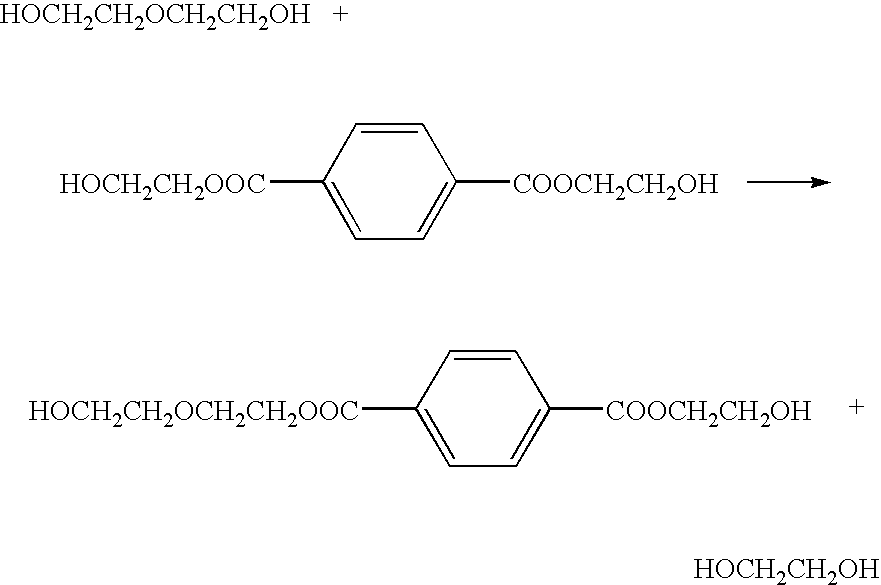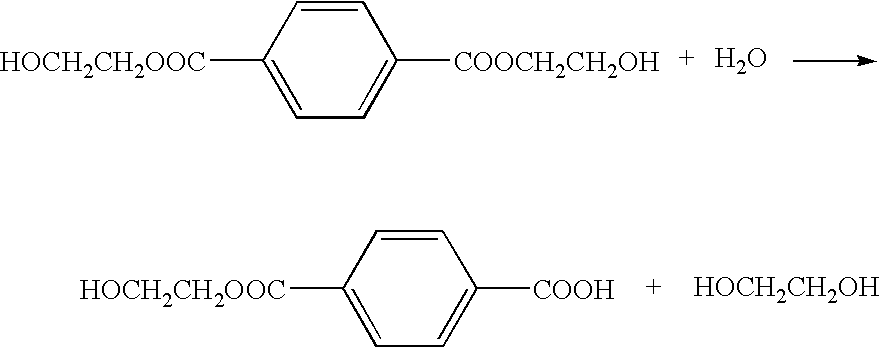Method of deionizing solution yielded by polyester decomposition with ethylene glycol
a technology of ethylene glycol and decomposition solution, which is applied in the direction of ion exchange treatment, carboxylic acid esters separation/purification, water/sewage treatment, etc., to achieve the effect of suppressing hydrolysis reaction, shortening the residence time of cation exchange treatment, and small reduction in yield and purity
- Summary
- Abstract
- Description
- Claims
- Application Information
AI Technical Summary
Benefits of technology
Problems solved by technology
Method used
Image
Examples
example 1
[0044]76 kg of flakes having an average size of 8 mm×8 mm and prepared by crushing used PET bottles (comprising a polyethylene terephthalate resin) together with 10 wt % of colored PET bottles, 424 kg of industrial grade ethylene glycol, and 230 g of industrial grade sodium hydroxide were charged into a 800-liter autoclave. While the mixture was being stirred at a pressure of 0.13 MPa and a temperature of 215° C., low-boiling-point materials such as water were distilled out from the top of a distillation column disposed in the autoclave, thereby carrying out glycolysis for 110 minutes.
(Removal of Impurities)
[0045]The obtained decomposition produced solution was cooled to 180° C. so as to remove solid impurities such as caps and labels contained in the flakes by means of a 60-mesh line strainer, and the resulting solution was transferred to a 800-liter cooling bath. The solution was kept in the cooling bath at 85° C. for 3 hours during which a blue pigment and other insol...
example 2
[0051]Purified bis(2-hydroxyethyl)terephthalate was obtained in the same manner as in Example 1 except that the residence time in the cation exchange treatment was changed to 30 minutes. The results are shown in Table 1.
example 3
[0052]Purified bis(2-hydroxyethyl)terephthalate was obtained in the same manner as in Example 1 except that the residence time in the cation exchange treatment was changed to 60 minutes. The results are shown in Table 1.
[0053]In addition, 5 wt % of water was added to the solution subjected to the cation exchange treatment, and a proportion of mono(2-hydroxyethyl)terephthalate converted from bis(2-hydroxyethyl)terephthalate in the whole solution was measured on a weight basis upon passages of 10, 20, 40, 60 and 120 minutes. As a result, it was 2.5% before the addition of water and then increased to 3.0%, 3.6%, 4.0%, 5.7% and 9.1% successively. Thereby, it was confirmed that mono(2-hydroxyethyl)terephthalate increased with passage of time.
PUM
| Property | Measurement | Unit |
|---|---|---|
| temperature | aaaaa | aaaaa |
| electric conductivity | aaaaa | aaaaa |
| size | aaaaa | aaaaa |
Abstract
Description
Claims
Application Information
 Login to View More
Login to View More - R&D
- Intellectual Property
- Life Sciences
- Materials
- Tech Scout
- Unparalleled Data Quality
- Higher Quality Content
- 60% Fewer Hallucinations
Browse by: Latest US Patents, China's latest patents, Technical Efficacy Thesaurus, Application Domain, Technology Topic, Popular Technical Reports.
© 2025 PatSnap. All rights reserved.Legal|Privacy policy|Modern Slavery Act Transparency Statement|Sitemap|About US| Contact US: help@patsnap.com


